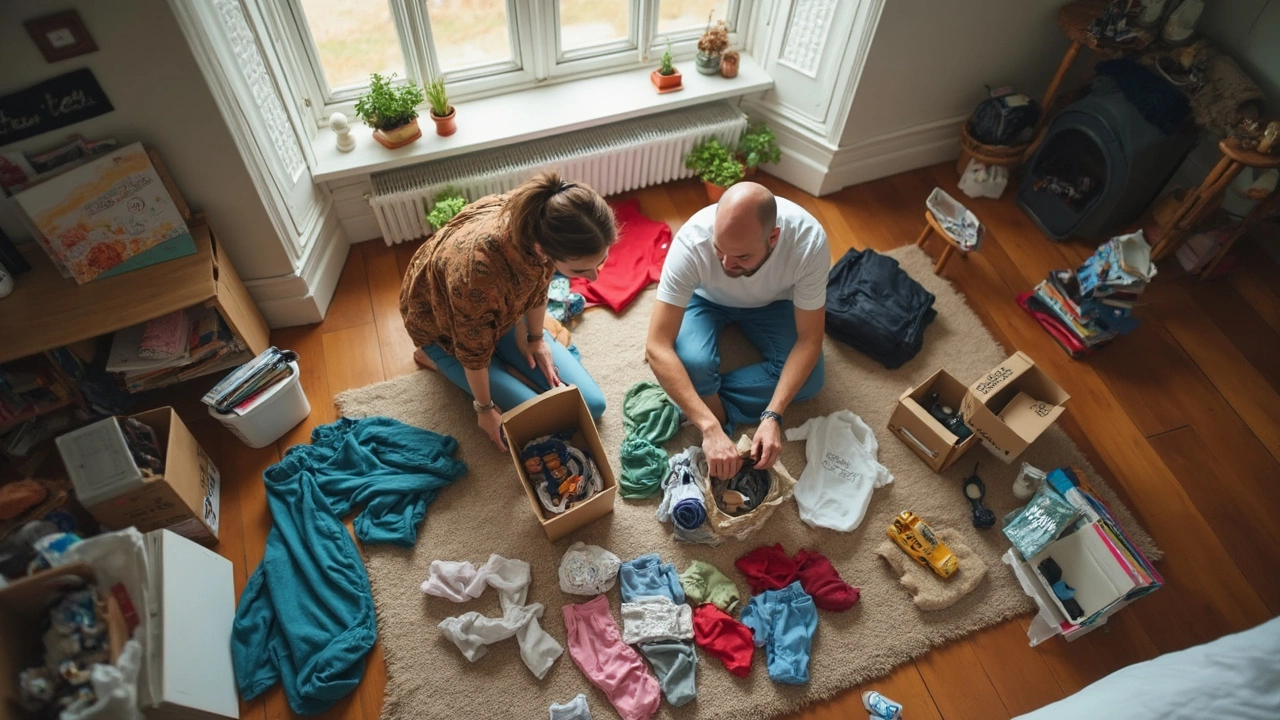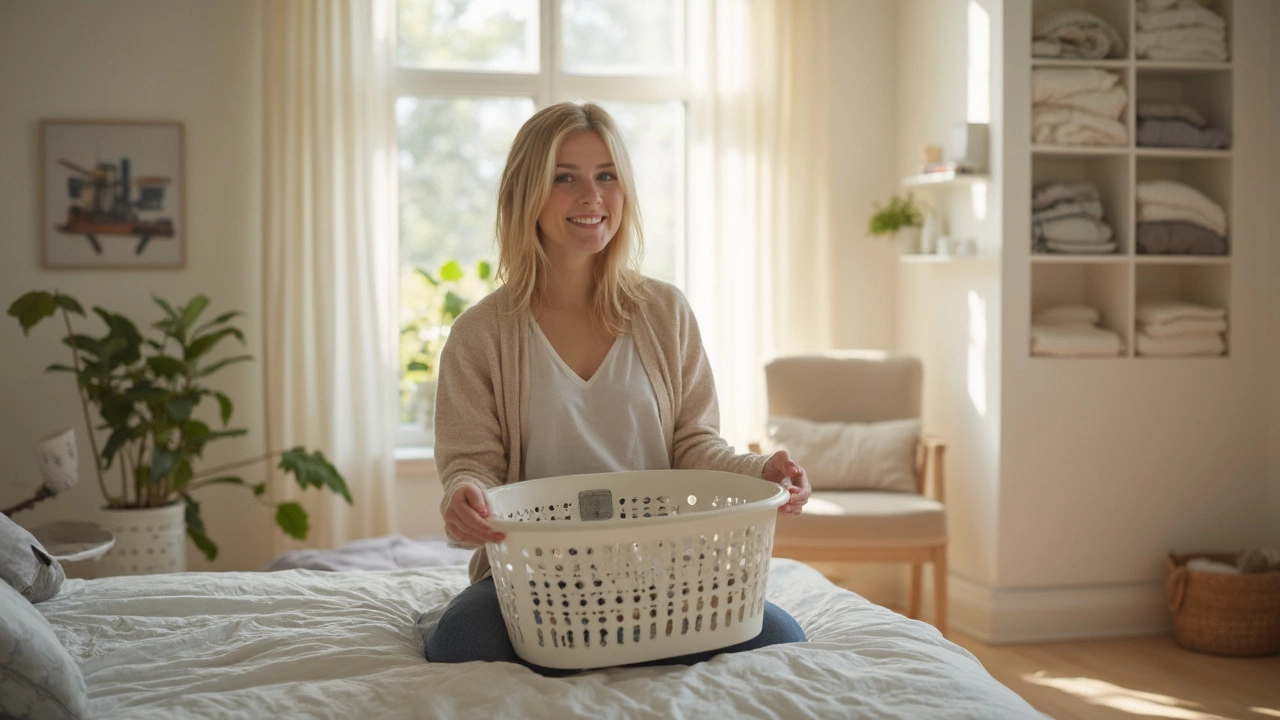If your bedroom feels more like a dumping ground than a peaceful escape, you’re not alone. Most folks wrestle with bedroom clutter, and it gets overwhelming fast. Shoes pile up, nightstands turn into junk drawers, and before you know it, you can’t remember the color of your carpet.
The first thing to get straight: you don’t need fancy bins or a full day off to make progress. Real change starts with ten minutes and a trash bag. Trash the obvious stuff—wrappers, dead batteries, random papers, socks with mystery holes. This clears a chunk of space right away, and you’ll see a difference almost instantly.
Next, do a quick sweep of surfaces. Take everything off your nightstand, dresser, and bedside tables. Only put back what you use every single night. You don’t need six mugs, three half-empty lotion bottles, or that tangle of charging cords you haven’t touched since last year.
- Why Your Bedroom Gets Cluttered
- Sort, Purge, and Donate
- Easy Storage Solutions
- Small Habits That Stop the Clutter Creep
- What to Do With Sentimental Stuff
- Setting Up a Bedroom That Stays Tidy
Why Your Bedroom Gets Cluttered
It’s wild how fast clutter sneaks into bedrooms, even when you swear you just cleaned. Most people use their bedrooms for way more than sleeping—think laundry fold pile, work-from-bed office, or last resort storage spot. That right there is part of the problem.
The main reason bedrooms get cluttered? They turn into holding zones for things that don’t have a set home elsewhere. Clothes get dropped on the chair "just for tonight" and then live there for weeks. Books, gadgets, and gym bags migrate in and set up camp because, honestly, it feels easier to dump than to deal.
Here’s the real kicker: according to a small survey by the National Association of Professional Organizers, around 54% of people say their biggest source of stress at home is due to clutter—most of that piles up in the bedroom. Even more surprising, about 1 in 4 admit they routinely let laundry live on floors or beds for days.
| Common Clutter Causes | % of People Affected (2024) |
|---|---|
| Unworn clothes piling up | 63% |
| Papers/misc items with no home | 44% |
| Laundry left out | 56% |
| Gadgets/chargers scattered | 39% |
| Sentimental items stored | 28% |
Bedrooms are private, so it’s easy to ignore the mess. Nobody sees it but you (or maybe your spouse if you have one like Maxwell, who believes socks belong everywhere but the hamper). This makes it tempting to push off tidying until you can’t stand it anymore.
And when you’re tired—whether from work or just a long day—it’s far easier to throw things into a pile than to put them away. Before you know it, bedroom clutter starts to feel like an unfixable part of life. But it's just the result of habits, not a life sentence. We'll tackle how to break the cycle in the next sections.
Sort, Purge, and Donate
This is the part that makes people groan—the sorting and purging. But it’s also the fastest way to see real progress on stubborn bedroom clutter. Grab three bags or boxes: one for trash, one for giving away, and one for things you need to keep but that don’t belong in the bedroom (looking at you, kitchen scissors or at least five stray single socks).
Here’s a quick and effective way to sort:
- Dump everything from drawers, closets, and under the bed onto the bed (yep, all of it). It will look wild, but this move keeps you from skipping items 'just in case.'
- Pick up each thing and ask: do I love it, use it, or need it? Anything that gets a hard ‘no,’ toss it or set it aside for donation.
- Bag up clothes you haven’t worn in a year, unread books, and random extras. Thrift stores are all about those donations. According to Goodwill, every 25 pounds of donations keeps stuff out of the landfill and funds job training—which is a win-win.
It helps to remember: the fewer things you own, the less you have to tidy later. The National Association of Productivity & Organizing Professionals says it can take up to 20 minutes daily just to manage excess items—imagine clawing that time back.
| Item | Keep | Donate/Sell | Toss |
|---|---|---|---|
| Clothes | Worn last 12 months | Gently used, outgrown | Stained, torn |
| Books | Favorites, re-read | Unwanted, duplicates | Water-damaged |
| Electronics | Working, used | Good condition, unused | Broken, outdated |
| Decor/Extras | Loved, used | Still nice, unwanted | Broken |
Once you’ve sorted, deliver that donation bag as soon as you can—don’t let it clutter up your hall for a month.
“Clutter isn’t just the stuff in your closet. It’s anything that gets between you and the life you want to be living.” — Peter Walsh, organizing expert
Stay strict and honest with yourself. Getting real about what you actually use and love is the key to beating bedroom clutter for good.
Easy Storage Solutions
If your bedroom looks clean for about a day before clutter sneaks back, it’s probably because you don’t have enough smart places to store stuff. You don’t need to buy a new closet system (unless you want to). Most of the time, it’s about using the space you do have way better.
The simple truth? Most people only use about 60% of their available bedroom storage. Think under the bed, behind the door, and inside those deep dresser drawers. Here’s how you can get more out of every inch:
- Bedroom clutter drops dramatically when you put storage bins or rolling drawers under the bed. Toss in shoes, extra blankets, or off-season clothes. Clear ones make it easy to spot what’s inside.
- Over-the-door hooks or shelves are gold for keeping bags, hoodies, or tomorrow’s outfit off the floor. It takes five minutes to install, no drill needed.
- Put drawer dividers or old shoe boxes inside your dresser. Suddenly, socks aren’t eating your T-shirts, and you aren’t digging for underwear in the dark.
- Nightstands with drawers or shelves give you a spot for books, chargers, and notebooks—so nothing piles up on top.
- If your closet is small, use slim hangers and add a second hanging bar. One study found you can boost hanging space by 33% with double rods.
Here’s what storage success can look like in everyday numbers:
| Item | Estimated Storage Gains |
|---|---|
| Under-bed bins (2-4 total) | Up to 16 cubic feet |
| Over-door organizer | Holds 10+ pairs of shoes or 6-8 sweaters |
| Drawer dividers | Make 30% more usable space per drawer |
Don’t forget vertical space. A simple shelf above a door or window can hold baskets for hats, scarves, or old photo albums. Hooks work in awkward corners most people ignore. The less stuff sitting out with no home, the less mess you’ll find when you wake up tomorrow morning.

Small Habits That Stop the Clutter Creep
Clutter rarely happens overnight. Usually, it’s a slow build—a sock tossed on the floor here, a receipt piled on your dresser there. Breaking that cycle is totally possible, but it’s not about one huge cleaning day every month. It’s about little things you do without even thinking. The key? Stick with habits that are simple enough to actually keep going.
Start with the most obvious: make your bed every morning. Not exactly groundbreaking, right? But science backs it up. The National Sleep Foundation found that people who make their bed daily are 19% more likely to say they get a good night’s sleep. A made bed sets the tone for a tidy room. It takes less than two minutes and instantly makes the space look less chaotic.
- Bedroom clutter is less likely to sneak back if you do a daily two-minute tidy before heading out or turning in.
- Keep a laundry basket in the room. Toss clothes right in and make a habit of emptying it every couple of days. No more "chairdrobe."
- Set a rule: nothing gets left on the nightstand except your current book, your lamp, and maybe one thing you use every day (like lip balm). Put the rest away or toss it.
- Follow the “one in, one out” rule. When you buy a new shirt or pillow, donate or toss an old one. Keeps your stuff in check without turning your closet into Narnia.
- Use small trays or baskets for those little things that always roam—hair ties, loose change, or earbuds.
I love this from organization expert Marie Kondo:
“The best way to find out what we really need is to get rid of what we don’t.”
For folks who love hard numbers, check this out. A study by UCLA’s Center on Everyday Lives of Families found that 75% of families say their home is too cluttered, but taking even five minutes each day makes a visible dent over time. Here’s what a quick tidy can do each week:
| Daily Tidy Habit | Time Spent per Week | Change in Room Appearance |
|---|---|---|
| Make the bed | 14 minutes | Room looks orderly |
| Put clothes away nightly | 21 minutes | No laundry piles anywhere |
| Clear surfaces nightly | 14 minutes | Surfaces stay clean |
| Empty trash once/week | 3 minutes | No junk or weird smells |
For me, it helps to tie a habit to another habit—like putting away tomorrow’s outfit right before brushing my teeth. Stack these little behaviors and before you know it, your room won’t have the chance to get wild again.
What to Do With Sentimental Stuff
Tackling sentimental items is where decluttering usually gets tricky. We all hang onto things that remind us of good times, people, or places. But when your bedroom starts turning into a museum—or worse, a storage unit—it’s time to rethink how you handle these keepsakes.
Research from UCLA's Center on Everyday Lives of Families actually found that dealing with sentimental items is the biggest roadblock when people try to get rid of clutter. The emotional weight slows everything down. But you can make it easier on yourself.
“No memory is in the object itself. It’s in you. Letting go of the item doesn’t erase the memory.” — Marie Kondo, author of 'The Life-Changing Magic of Tidying Up'
Here are a few tips that work for a lot of people:
- Pick a limit: Set a clear size for your "memory box"—something that fits on a shelf or in a drawer. When the box is full, it’s time to sort.
- Take pictures: Snap a photo of bulky items like old trophies or childhood crafts. It’s less to store, but you still keep the memory.
- Display the best: Choose a few meaningful pieces—like a framed photo or your grandmother’s necklace—and make them part of your bedroom decor.
- Check your why: Ask yourself if you genuinely want the item, or if you just feel guilty throwing it away. Guilt is a terrible decorator.
Studies say that people keep an average of 80 items just for sentimental reasons in their bedrooms. That adds up! Here’s a quick breakdown of common sentimental clutter:
| Type | Average Per Bedroom |
|---|---|
| Old Cards/Letters | 22 |
| Childhood Keepsakes | 15 |
| T-Shirts/Clothes | 12 |
| Photos (not displayed) | 19 |
| Misc. Trinkets | 12 |
If detaching feels hard, ask a friend or your partner to talk through it with you. Sometimes you just need to say out loud why you’re keeping something. I do this with Maxwell sometimes, and nine times out of ten, I end up tossing what I thought I’d never part with. The bottom line: save what lights you up and let go of the rest. You want a bedroom for living—not just storing memories.
Setting Up a Bedroom That Stays Tidy
Here’s the deal—a bedroom that stays organized isn’t just about one big clean-out and then hoping for the best. It’s a set of simple habits and the right setup. As wild as it sounds, studies say the average adult spends about 70 hours a year just looking for lost stuff at home. That’s almost three days you could be binging your favorite show or catching some actual sleep. So, let’s get you set up so things stay where they belong.
Start by making sure everything in your bedroom has a dedicated spot. Not a vague “over there,” but a real home. This cuts down on chaos big time. You want your bedroom clutter to vanish—and stay gone. Here’s how to set yourself up for success:
- Go for easy-access storage. Use bins or baskets under the bed instead of piling things in the corner. Open shelves work great for books and folded jeans. Shoes? A rack or a tray keeps them from scattering everywhere.
- Use bedside organizers. A caddy on your nightstand for glasses, chargers, and the current book stops you from piling up random objects. Drawer dividers inside help too. It makes a difference when you don’t have to dig around each night.
- Limit what’s on your surfaces. Try a “one-in, one-out” rule: if you add a new candle or trinket, retire another. If it’s not in daily use, store it or donate.
- Don’t forget wall hooks. These are life-savers for jackets, bags, or tomorrow’s clothes. Command Hooks don’t need tools or holes, and you can move them if you change your mind.
Let’s see a quick data snapshot showing how keeping things streamlined can improve your daily routine:
| Routine Change | Time Saved Per Week |
|---|---|
| Putting laundry away right after folding | 30 minutes |
| Clearing surfaces nightly | 15 minutes |
| Setting up a donation box | 10 minutes |
If you split basic tidying into 5-10 minutes a day, you barely notice the effort, but your bedroom somehow never slides back into chaos. My spouse, Maxwell, once bet me he could keep his half of the closet mess-free for a month using drawer organizers—and, shockingly, he won. Turns out, the right tools really do help.
A tidy bedroom isn’t about perfection—it’s about making peaceful mornings and stress-free bedtimes your new normal. Set a reminder on your phone for a quick surface sweep before bed, and you’ll be amazed how easy it is to stay on top of the mess.


